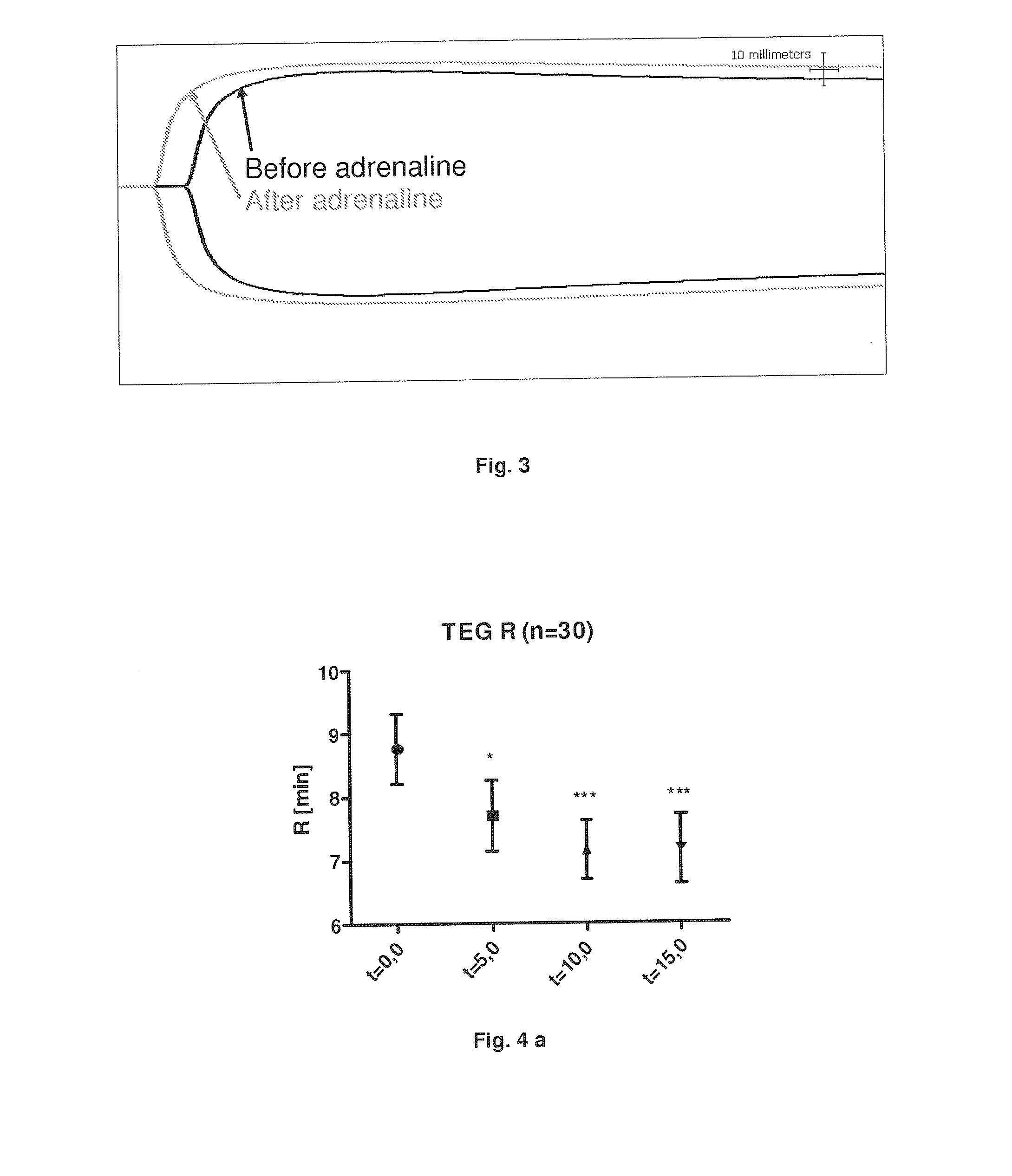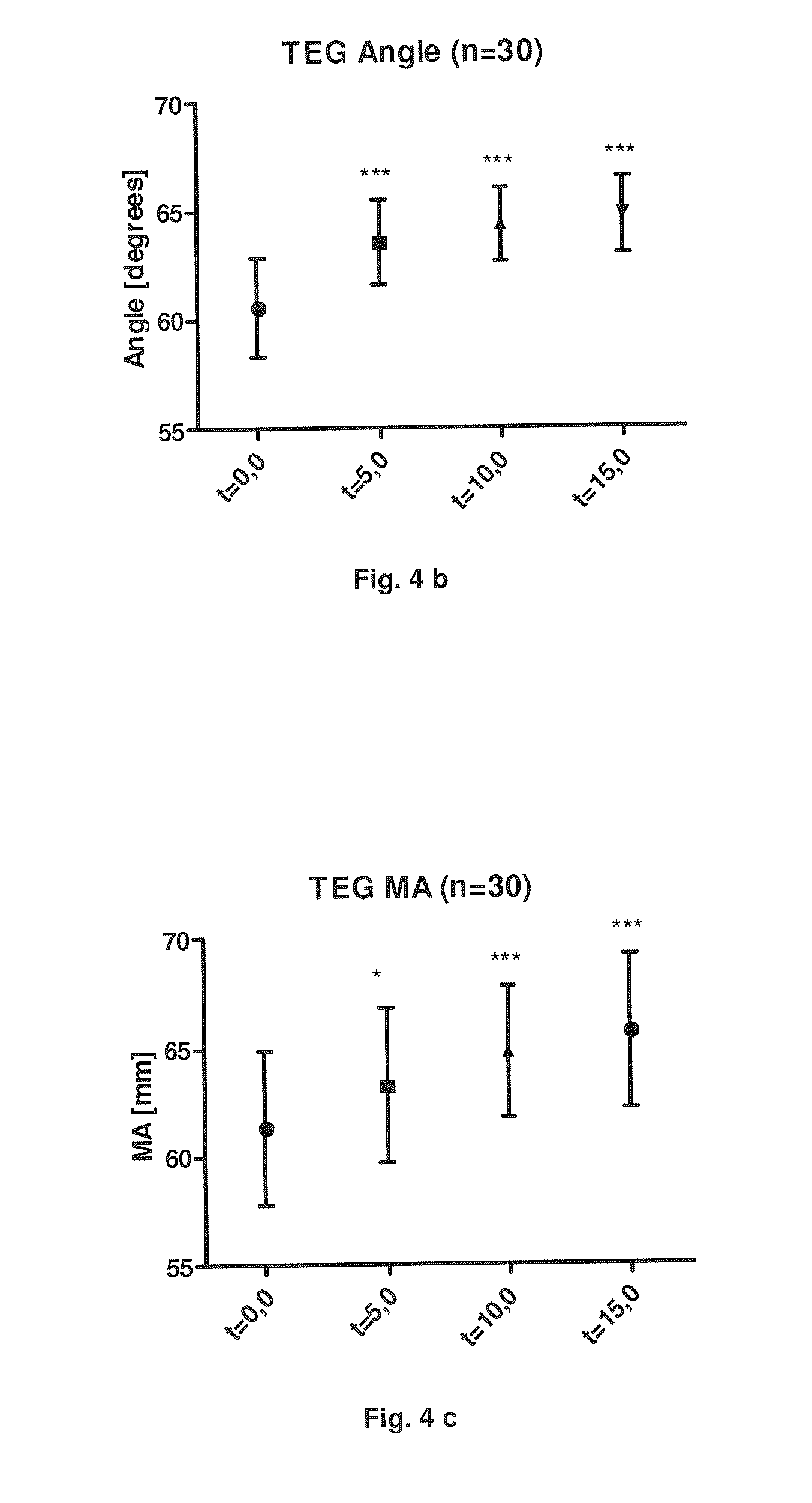Systemic Pro-hemostatic Effect of Sympathicomimetics with Agonistic Effects on Alfa-Adrenergic and/or Beta-Adrenergic Receptors of the Sympathetic Nervous System, Related to Improved Clot Strength
a sympathetic nervous system and sympathicomimetics technology, applied in the direction of instruments, extracellular fluid disorders, peptides/protein ingredients, etc., can solve the problems of increased multiorgan failure, fibrin clot formation, and increased blood loss, so as to avoid side effects, increase blood loss, and avoid bleeding.
- Summary
- Abstract
- Description
- Claims
- Application Information
AI Technical Summary
Benefits of technology
Problems solved by technology
Method used
Image
Examples
example 1
Thrombelastography (TEG)
[0270]The TEG in vitro assay is suitable for determining important parameters in the hemostatic process including clot strength. The TEG system's approach to monitoring patient hemostasis is based on the premise that the end result of the hemostatic process is the clot. The clot's physical properties determine whether the patient will have normal hemostasis, or will be at increased risk for haemorrhage or thrombosis [Salooja et al. 2001].
[0271]The TEG analyzer uses a small whole blood sample in a rotating cup and a pin suspended in the blood by a torsion wire, which is monitored for motion. The torque of the rotating cup is transmitted to the immersed pin only after fibrin and / or fibrin-platelet bonding has linked the cup and pin together (FIG. 1). The strength and rate of these bonds affect the magnitude of the pin motion such that strong clots move the pin more than less strong clots. Thus, the TEG technology documents the interaction of platelets with the ...
example 2
[0275]We have identified a pro-hemostatic effect of administration of sympathicomimetics, as exemplified by adrenaline infusion in 30 healthy subjects (FIGS. 3 and 4), patients prior to surgery (FIG. 7), as well as after noradrenaline administration in 10 healthy subjects (FIG. 5).
[0276]We have found a dose dependent increase in the pro-hemostatic effect of administration of sympathicomimetics where a dose of 1 microgram / kg / hour resulted in a smaller change as compared to baseline than 2 microgram / kg / hour did and the pro-hemostatic effect was further improved when 3 microgram / kg / hour was administered (FIG. 7). A dose-dependent increase in MA response was additionally observed in a series of adrenaline infusion in the doses 3.5, 5.0, 6.0 μg / kg / h (FIG. 4c).
example 3
The Effect of Administration of Adrenaline by Intravenous Infusion on TEG Parameters in 10 Consecutive Patients Undergoing Prostatectomy.
[0277]Patients undergoing prostatectomy were anaesthetized by propofol and haldid. Prior to skin incision the patients received a step-wise i.v. infusion of adrenaline in the doses 1, 2 and 3 μg / kg / h each for 5 minutes. TEG analyses were performed as described in example 1, exactly 30 minutes after collection of arterial blood. Blood samples were obtained before and after each dose and 1 hour after discontinuation of adrenaline infusion. As illustrated in FIG. 7a-c administration of adrenaline result in a significantly faster initiation of the coagulations process (R decreased), increased rate of amplification and increased rate of propagation and thrombin generation (increased Angle) and an increased mechanical strength of the clot (increased MA). Furthermore, the pro-hemostatic effect of adrenaline on clot strength (MA) is abated 60 min after dis...
PUM
| Property | Measurement | Unit |
|---|---|---|
| half life | aaaaa | aaaaa |
| half life | aaaaa | aaaaa |
| particle size | aaaaa | aaaaa |
Abstract
Description
Claims
Application Information
 Login to View More
Login to View More - R&D
- Intellectual Property
- Life Sciences
- Materials
- Tech Scout
- Unparalleled Data Quality
- Higher Quality Content
- 60% Fewer Hallucinations
Browse by: Latest US Patents, China's latest patents, Technical Efficacy Thesaurus, Application Domain, Technology Topic, Popular Technical Reports.
© 2025 PatSnap. All rights reserved.Legal|Privacy policy|Modern Slavery Act Transparency Statement|Sitemap|About US| Contact US: help@patsnap.com



